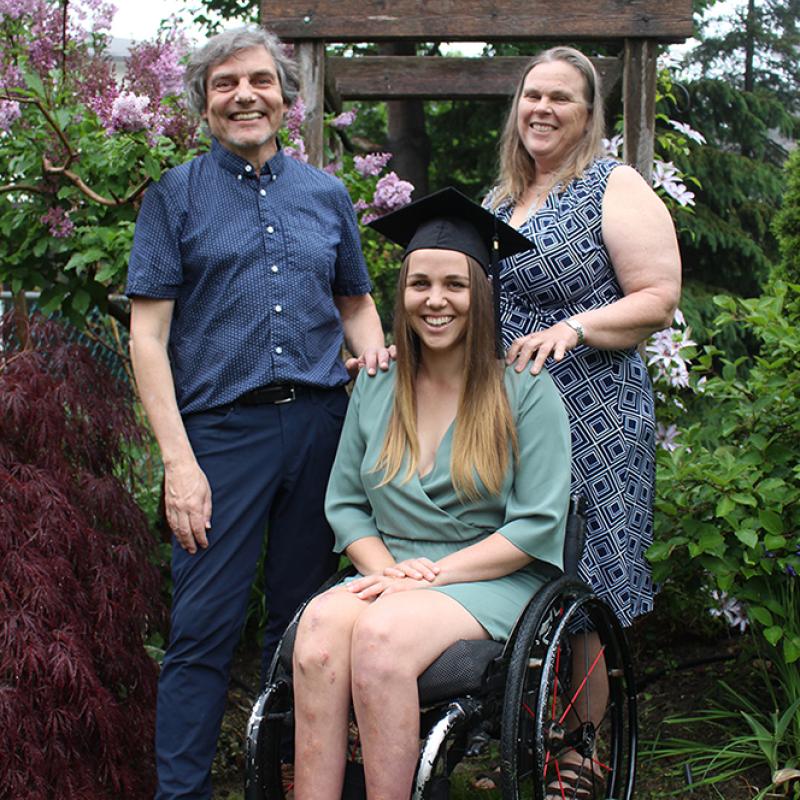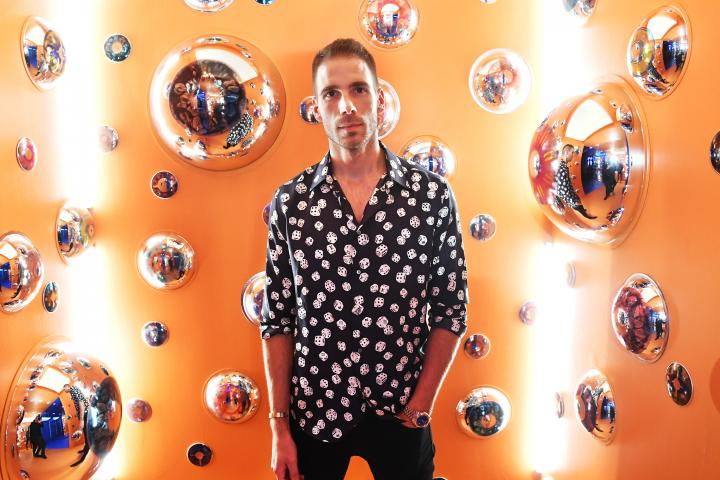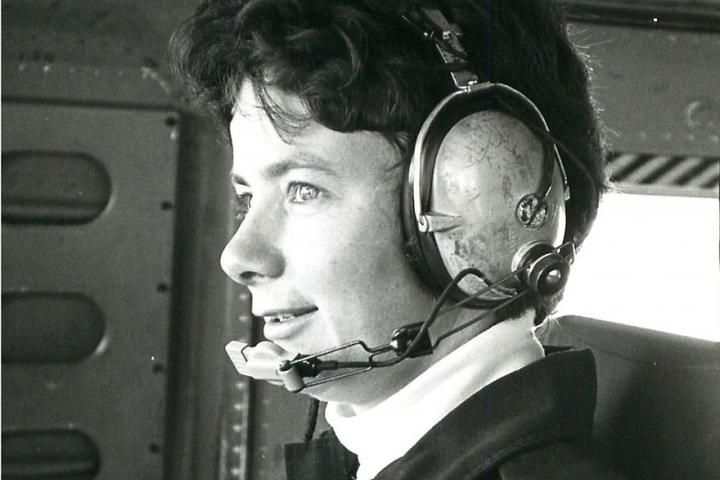It is fair to say that most of Katie Combaluzier’s plans for life were shattered on a French mountainside in 2018. But how she rebuilt that life, piece by painstaking piece, is the story of a force of will that turned out to be just as strong as the avalanche that hit her like a snow-covered freight train, took the life of her friend, and robbed her of her mobility.
Dr. Katie Combaluzier, Artsci’16, is, herself, a force of nature. Her tenacity, courage, and resilience are testaments to the human spirit, packaged as they are in the joy with which she lives her life: a badge of triumph and, perhaps, defiance. For after all she has been through,
and all the things that might have stopped her, Dr. Combaluzier has never surrendered.
When she woke up in a hospital in France and was told she might never walk again, the then-24-year-old, who had childhood dreams of going to the Olympics, briefly paused and then said to herself, “Well, maybe I can go to the Paralympics.”
That’s also the first thing she told her parents when they arrived at her bedside. Then she started talking herself through how she would return to medical school and finish the remaining years of her degree at University College in Dublin.
Today, Dr. Combaluzier, a Toronto native who completed her undergrad in kinesiology at Queen’s, is finishing her residency in Gatineau, Que. When she’s done, she and her fiancé, Adam Doran, will move to Squamish, B.C., where she’ll continue to work part time while skiing and training full time. She’s aiming to return for her second Paralympics after competing in 2022 in Beijing, China, and is now training for Milano Cortina, Italy, in 2026. This time, she’s determined to bring home a medal for Canada. “That would be my biggest dream.”
Dreams of competing in the Olympics were a real thing for young Katie.
“I’ve been skiing since I was two years old,” she says, with her irrepressible smile. “I ski-raced and competed growing up and, of course, had dreams of going to the Olympics. So, when I had an accident, it didn’t matter that it happened skiing. It wasn’t something I was going to give up.”
In March 2018, Dr. Combaluzier had booked a reading week ski trip to Grenoble, France, with three students she’d connected with through a mutual friend. The four were backcountry skiing when an avalanche broke beneath their feet. Dr. Combaluzier screamed before a river of snow swept the skiers down the mountain. Suddenly, the earth was moving beneath her, she lost all sense of direction, and felt as if she was being crushed before she slammed into an avalanche barrier. Her back was fractured.
When it finally stopped, the horror of it all began to set in as she and her skiing companions shouted into the wind for help. The fourth member of their party, Sven Reichert, was missing. When they found him, his helmet was broken and bloody – he had been killed by the impact.At the time, CBC reported that rescuers’ attempts to use a helicopter had been thwarted by rapid cloud cover, so when Dr. Combaluzier was finally found, her crumpled body was strapped to a toboggan and lowered by ropes down the mountain. She later recalled that she was in excruciating pain, crying out for morphine, which rescuers administered on the spot. She didn’t need her early medical training to tell her the lack of feeling in her legs was a good indication of spinal-cord injury – she knew it in her heart.
It was, she later recalled, “the worst experience of my life.”
It was also a profound turning point, triggering a fierce determination in the face of an unthinkable tragedy. At the hospital in France, surgeons used a titanium plate to fuse three of her spinal discs. She was told she had little chance of ever walking again.
Yet, she was determined to overcome the injury and dedicated to realizing her new dream of becoming a Paralympian. She moved from diagnosis to the international pinnacle of Paralympic ski competition in fewer than four years – she graduated from medical school in the spring of 2021, as planned, despite having missed much of her second semester while in rehab in Canada; she was in the gym by July and on the slopes competing in elite races by November of that year; and, by March 2022, she was competing in the Beijing Paralympics.
“It came down to a lot of determination and focus,” she says. “I reached out to different coaches to get as much training as I could.”
In her joy, there’s a healthy, if occasionally dark, sense of humour. Pulling into Camp Fortune, a ski hill near Chelsea, Que., that she frequented last winter to keep up her skills, her Hyundai Santa Fe, retrofitted with hand controls, is parked in a plum spot on an extremely busy day – one of the perks, she jokes, of being disabled (the word she uses).
“The parking benefits, I tell ya!” she says.
A few days later, after she’s returned from placing fourth in a world championship competition in Switzerland, she’s at the Gatineau apartment she shares with her fiancé and their enthusiastic cockapoo, Perogi. Her phone rings and she excuses herself from an interview. In French, her second language, she speaks to the caregiver of a 90-year-old patient who needs an emergency infusion. Dr. Combaluzier tells them the test results that she just received indicate it’s urgent and she advises them to go to the emergency room. She’s well into overtime on another stressful day, but she’s doing something she loves – practising family medicine.
Her passion for her profession stems from her interest in the way the human body works.
I learned teamwork and communication from my coaches, Queen’s was great for creating a sense of community. My Queen’s roommates are still my best friends today.
“The classic answer for any doctor is ‘because I want to help people,’ but [for me,] it’s more just an interest in the science behind things that led me to this pathway. Kinesiology scratches the surface. As a family doc, we need to know absolutely everything there is to know. And I still learn something every day.”
The road to medicine started at Queen’s, where she learned to love athletics and academics, and to “nail” time management. In addition to a full course load, she had five practices a week as a member of the university’s sailing team. She also competed many weekends.
“I learned teamwork and communication from my coaches,” she says. “Queen’s was great for creating a sense of community. My Queen’s roommates are still my best friends today.”
She also volunteered with two programs for disabled adults at Kingston General and Hotel Dieu Hospital; this commitment gave her the experience she needed for med school applications.
She pauses, realizing the significance of her past work with patients with disabilities. “I’ve actually never made that connection before.”
After the avalanche, she immediately decided she would return to medical school.
“When the accident happened, I asked myself about the positives. Once something like that happens to you, there are opportunities thrown at you. I said yes to as many as I could. I felt fortunate to be able to go back to med school. I’d lost use of my legs, but my brain was still good.”
First, she had to persuade school administrators she was capable.
“I had to convince people I still deserved my place in medicine,” she says, as they offered her the option of dropping out. “I’m like, ‘Well, no, I want to come back.’”
There were obstacles to overcome in a less-than-modern medical school – no elevators, and doors that were too narrow. Participating in anatomy labs and surgeries was a challenge.
“I wasn’t allowed in the emergency room during medical training because they thought I would be in the way because of my chair,” she says. “I’ve had to advocate for myself. Just because I’m sitting doesn’t mean I’m not able to accomplish tasks; it just might take me a fraction longer.
“Having adaptability and the desire to overcome the obstacles helps. I’ve always been a very determined person. This was just a bump in the road.”
During her medical training and residency, she’s also had to deal with “prying” questions from skeptical patients and had to convince some patients – and even some colleagues – that she is a doctor.
“One time a random staff member told me to return to my room because they thought I was a patient,” she says. “Comments like that hurt, but you have to roll with it. I hope, with time, the public will become more used to seeing people with disabilities in the workforce.”
Recently, a supervising doctor she was meeting for the first time laughed when she saw Dr. Combaluzier in a wheelchair and asked why she was kidding around.
“I answered ‘No … I’m disabled,’” after which the supervisor was shocked and embarrassed. “She apologized for the rest of the shift. I don’t think she will ever make that mistake again.”
These hurdles add to the broader challenges of being a woman in medicine.
“It’s not that different from a female physician being mistaken for a nurse. I get that all the time, too. It’s one of those misconceptions and stereotypes people hold.”
After the accident, Dr. Combaluzier finished her first year remotely and returned to Ireland to complete her degree. In another example of the scale of her determination, she rejoined the rock climbing club she’d been part of before the accident. That’s when she and Mr. Doran, who had been a climbing acquaintance, started spending more time together. He’s a passionate, able-bodied rock-climber and he gives her the confidence to climb without the use of her legs. “He’s always going to make sure I’m safe.”
When she finished her medical degree, the couple moved to Canada for the 2021–22 ski season. Again defying expectations, they lived in a van in Whistler, B.C., to save money. Was it cold living in a van in the Rocky Mountains in winter?
“No!” she laughs. “We had a heater. I was going to be on the road for most of the year, so we were kind of bums. We ate a lot of perogies that year.” That’s where Perogi the cockapoo got his name.
At this point, she was racing with the Paralympic prospects group in Europe. After two silvers and a bronze at the world championships in Norway, she qualified for the Paralympics. Would she be invited? She trained, and waited, and finally got the call for Beijing.
“The Paralympics were everything!” she says. “They were a mix of fun and excitement, and the most stressful time of my life ever. All of a sudden, you’re on a world stage and there are cameras on you and you know your friends and family back home are watching you even though it’s 3 a.m. their time. It’s your time to shine, and I did not shine. For the first three races, I fell early on. It was the pressure to perform just mounting.”
She was not happy with her performance, but says there was value in knowing what it’s like to compete at the Paralympics. She hopes to use that knowledge to earn a medal at the Paralympics in Italy in 2026. And if she does, she’s heartened by the recent decision that Canadian Paralympians will be awarded the same prize money as their Olympic counterparts for winning medals, something that’s never happened in the past. That’s $20,000, $15,000, and $10,000 for gold, silver, and bronze respectively.
“I think it’s important, and it should have happened long ago.”
What Dr. Combaluzier describes as a bump in the road would be an insurmountable challenge for many. Her prescription for resilience? Focus on the positives and break challenges into smaller, more readily achievable goals. In other words, roll with it.
“I’m a cheery person, but I know that’s not easy for everyone. If you think too many steps into the future, it’s easy to get overwhelmed, so focus on minor steps. Make incremental gains and narrow your focus. Also, focus on the support you have. I was fortunate I had my family, but it can be difficult; I felt I had to be positive around other people. I saved the dark moments for myself.”
She foresees brighter moments once she and Mr. Doran, who works remotely as a software engineer, are living in Squamish. They plan a lot of rock climbing, an activity that’s just become a summer Paralympic sport.
“It would be cool to go to the Summer Games,” she says, showing photos of herself at Stawamus Chief (Siy'ám' Smánit), a granitic dome at Squamish. She also enjoys hand-cycling, another summer Paralympic sport, and she’s intrigued by the idea of vying for a spot on Canada’s cycling team.
She’s also focused on her career, with a goal to become a doctor for a Paralympic team. “That would be full circle for me.”







